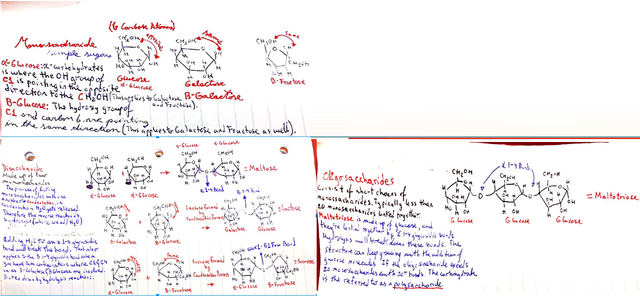
Carbohydrates are the main source of energy for us and they serve as structural components.
They mainly contain carbon, hydrogen and oxygen atoms in a molar ratio of 1 carbon: 2
hydrogens: 1 oxygen. We have Monosaccharides, Disaccharides, Oligosaccharides, and
Polysaccharides.
Polysaccharides also known as glycans can be labeled as polysaccharides or
heteropolysaccharides. A homopolysaccharide meaning the polysaccharide has only a single type
of monosaccharide (ex: only glucose molecules linked together). A heteropolysaccharide means
that the polysaccharide contains two or more different monosaccharides (ex: a chain of fructose
and glucose molecules). A polysaccharide can also be unbranched or it can be branched. This
goes for both homo polysaccharides as well as heteropolysaccharides. Heteropolysaccharides can
also be unbranched or branched. Homopolysaccharides serve as storage forms of
monosaccharides in both humans and plants as well as bacteria. Starch is a storage form of
monosaccharides in plants. Starch as we recall is one of the most popular carbohydrates in our
diets as well. It is made up of glucose and as stated, it is a homopolysaccharide. If starch is
unbranched (a chain of glucose linked together by alpha 1-4 glycosidic bonds), it can be called
amylose. If starch is branched, (contains alpha 1-4, and alpha 1-6 glycosidic bonds between
glucose), it is said to be amylopectin. Amylose and amylopectin are two forms of glucose
polymers. Glycogen is a homopolysaccharide as it is composed of glucose. It can be branched or
unbranched as well and it is a storage form of glucose in animals. Starch and glycogen are both
composed of glucose and can also be branched or unbranched (meaning they both contain
amylose and amylopectin but Glycogen has branch points occurring every eight to twelve
glucose residues whereas in starch it occurs every 24 to 30 glucose residues and this influences
the structure). Cellulose is an interesting structural component to discuss as it is made up of Beta
1-4 glycosidic bonds. We do not possess the enzymes to hydrolyze (break down) Beta 1-4
glycosidic bonds of cellulose and as a result, we cannot digest it.
Hi! I am a robot. I just upvoted you! I found similar content that readers might be interested in:
https://en.wikibooks.org/wiki/Structural_Biochemistry/Carbohydrates/Polysaccharides
Downvoting a post can decrease pending rewards and make it less visible. Common reasons:
Submit